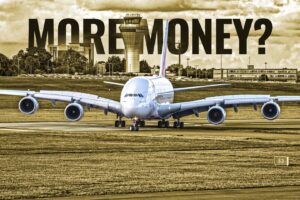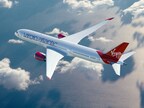
Boeing made this announcement:
The Boeing Company reported first quarter revenue of $16.9 billion, GAAP loss per share of ($1.11) and core loss per share (non-GAAP)* of ($1.70), primarily reflecting the impacts of COVID-19 and the 737 MAX grounding (Table 1). Boeing recorded operating cash flow of ($4.3) billion.
“The COVID-19 pandemic is affecting every aspect of our business, including airline customer demand, production continuity and supply chain stability,” said Boeing President and CEO David Calhoun. “Our primary focus is the health and safety of our people and communities while we take tough but necessary action to navigate this unprecedented health crisis and adapt for a changed marketplace.”
As the pandemic continues to reduce airline passenger traffic, Boeing sees significant impact on the demand for new commercial airplanes and services, with airlines delaying purchases for new jets, slowing delivery schedules and deferring elective maintenance. To align the business for the new market reality, Boeing is taking several actions that include reducing commercial airplane production rates. The company also announced a leadership and organizational restructuring to streamline roles and responsibilities, and plans to reduce overall staffing levels with a voluntary layoff program and additional workforce actions as necessary.
Boeing has also taken action to manage near-term liquidity, as it has drawn on a term loan facility; reduced operating costs and discretionary spending; extended the existing pause on share repurchases and suspended dividends until further notice; reduced or deferred research and development and capital expenditures; and eliminated CEO and Chairman pay for the year. Access to additional liquidity will be critical for Boeing and the aerospace manufacturing sector to bridge to recovery, and the company is actively exploring all of the available options. Boeing believes it will be able to obtain sufficient liquidity to fund its operations.
“While COVID-19 is adding unprecedented pressure to our business, we remain confident in our long term future,” said Calhoun. “We continue to support our defense customers in their critical national security missions. We are progressing toward the safe return to service of the 737 MAX, and we are driving safety, quality and operational excellence into all that we do every day. Air travel has always been resilient, our portfolio of products and technology is well positioned, and we are confident we will emerge from the crisis and thrive again as a leader of our industry.”
Financial results significantly impacted by COVID-19 and the 737 MAX grounding
Revenue of $16.9 billion, GAAP loss per share of ($1.11) and core (non-GAAP)* loss per share of ($1.70)
Operating cash flow of ($4.3) billion; cash and marketable securities of $15.5 billion
Total backlog of $439 billion, including over 5,000 commercial airplanes
Table 1. Summary Financial Results
First Quarter
(Dollars in Millions, except per share data)
2020
2019
Change
Revenues
$16,908
$22,917
(26)%
GAAP
(Loss)/Earnings From Operations
($1,353)
$2,350
NM
Operating Margin
(8.0)%
10.3%
NM
Net (Loss)/Earnings
(641)
$2,149
NM
(Loss)/Earnings Per Share
($1.11)
$3.75
NM
Operating Cash Flow
($4,302)
$2,788
NM
Non-GAAP*
Core Operating (Loss)/Earnings
($1,700)
$1,986
NM
Core Operating Margin
(10.1)%
8.7%
NM
Core (Loss)/Earnings Per Share
($1.70)
$3.16
NM
Commercial Airplanes first-quarter revenue was $6.2 billion reflecting lower deliveries driven by the 737 MAX grounding as well as impacts of COVID-19 (Table 4). First-quarter operating margin decreased to (33.3) percent due to lower delivery volume, $797 million of abnormal production costs from the temporary suspension of 737 MAX production, a $336 million charge related to 737 Next Generation frame fitting component (pickle fork) repair costs, lower 787 margins primarily due to COVID-19, and $137 million of abnormal production costs from the temporary suspension of Puget Sound operations in response to COVID-19.
COVID-19 has adversely impacted the 737 program due to a slower than previously planned production rate ramp-up driven by commercial airline industry uncertainty. To reflect COVID-19 impacts on the demand environment, 737 MAX aircraft production will resume at low rates in 2020 as timing and conditions of return to service are better understood and gradually increase to 31 per month during 2021, with further gradual increases to correspond with market demand. The estimated abnormal production costs from the temporary suspension of 737 MAX production have increased by approximately $1 billion due to updated production rate assumptions, bringing the estimated total to approximately $5 billion. There was no material change to estimated potential concessions and other considerations to customers related to the 737 MAX grounding.
Commercial Airplanes has updated its production rate assumptions to reflect impacts from COVID-19 on its operations and demand outlook, and will continue to assess them on an ongoing basis. The 787 production rate will be reduced from 14 per month to 10 per month in 2020, and gradually reduced to 7 per month by 2022. The 777/777X combined production rate will be reduced to 3 per month in 2021. At this time, production rate assumptions have not changed on the 767 and 747 programs.
Commercial Airplanes delivered 50 airplanes during the quarter, including 29 787s. Commercial Airplanes captured an order for 12 787 aircraft for All Nippon Airways, and produced the 1000th 787 at Boeing South Carolina. Commercial Airplanes backlog included over 5,000 airplanes valued at $352 billion.
Boeing President and CEO Dave Calhoun issued the following letter to employees today addressing aerospace market realities:
Team:
The global pandemic has changed the way we live and work. It is changing our industry. We are facing utterly unexpected challenges. But across the world you are demonstrating the resilience, commitment and generosity to one another, our customers and our communities that Boeing people are known for. I deeply appreciate all that you do.
And if COVID-19 has affected you directly — your health, your well-being, your loved ones or your colleagues — you have my sympathy and support.
The pandemic is also delivering a body blow to our business — affecting airline customer demand, production continuity and supply chain stability. The demand for commercial airline travel has fallen off a cliff, with U.S. passenger volumes down more than 95% compared to last year. Globally, commercial airline revenue is expected to drop by $314 billion this year.
As a result, airlines are delaying purchases for new jets, putting the brakes on delivery schedules and deferring elective maintenance. We’re also seeing a dramatic impact on our commercial services business, as grounded airline fleets decrease the demand for our offerings.
All of this puts near-term pressure on our cash flow. We’re taking steps to keep liquidity flowing through our business and supply chain. We’re reducing operating costs and discretionary spending, suspending dividend payments, extending our existing pause on stock buybacks, reducing or deferring R&D and capital expenditures, and accelerating some progress payment receipts with help from our defense customers. Our chairman and I are also foregoing our salaries for the year. And as you know, we’re exploring potential government funding options and advocating for access to credit for the entire aerospace manufacturing supply chain.
The aviation industry will take years to return to the levels of traffic we saw just a few months ago. We have to prepare for that. In today’s first-quarter earnings disclosure, we will be announcing a number of steps we’re taking to meet that new reality. Specifically, we will have to reduce commercial airplane production rates:
We expect to resume 737 MAX production at low rates in 2020, gradually increasing to 31 planes per month during 2021, with gradual increases to correspond to market demand.
We plan to reduce the 787 production rate to 10 per month in 2020 and to 7 per month by 2022, continuing to evaluate the rate after that.
We also plan to reduce the combined 777 / 777X production rate to 3 per month in 2021 and take a measured approach to the 777X rate ramp.
The 767 and 747 production rates will remain unchanged.
We have done a tremendous job of increasing our production rates and services offerings in recent years. But the sharp reduction in demand for our products and services over the next several years simply won’t support the higher levels of output.
We have worked hard to maintain the stability of our workforce, avoiding layoffs even through the grounding of the 737 MAX.
But these new reductions in our production rates and the continued impact of COVID-19 on our business will force us to reduce the size of our workforce. I’m sorry that I have to deliver this news, but I wanted you to hear it from me first — and I recorded a video message so you could hear it from me directly.
We have begun taking action to lower our number of employees by roughly 10% through a combination of voluntary layoffs (VLO), natural turnover and involuntary layoffs as necessary.
That is 10% in total for the enterprise. We’ll have to make even deeper reductions in areas that are most exposed to the condition of our commercial customers — more than 15% across our commercial airplanes and services businesses, as well as our corporate functions.
At the same time, the ongoing stability of our defense, space and related services businesses will help us limit the overall depth of the cut. And in the end, because there are so many unpredictable drivers for this crisis, we’ll have to monitor continuously what’s happening in our markets, and we will make adjustments whenever needed to ensure we’re matching the size of our business to the changing demand in the market.
I know this news is a blow during an already challenging time. I regret the impact this will have on many of you. I sincerely wish there were some other way.
Please know that we will do everything we can to minimize that impact, and as we take these steps, we will be as fair and transparent as possible — and absolutely honest and respectful.
The VLO program provides eligible team members with an opportunity to depart the company with a pay and benefits package. We also will provide support for those affected by involuntary layoffs, including severance pay, COBRA health care coverage and career transition services.
We are also making changes to start restructuring from the top so we’re ready for the new market reality — shrinking the size of my team by consolidating roles, simplifying processes and focusing accountabilities.
Please know this: Our industry and our company will get through this. Air travel has always been resilient over the long term, and our portfolio of products, services and technology is well-positioned for the recovery that will come.
And even as we deal with this crisis, we are pushing forward with our 2020 priorities:
We are progressing toward the safe return to service of the 737 MAX in close coordination with the U.S. Federal Aviation Administration and global regulators.
We’re making progress on our development programs, including the 777X, 737 MAX 10 and CST-100 Starliner.
We continue to support our defense customers with progress across our future franchise programs, including MQ-25, T-7A Red Hawk, MH-139A Grey Wolf and our extra large unmanned undersea vehicle.
Our Government Services business is growing as we earn new and follow-on business with our global defense customers, who look to us to support their fleet performance and mission readiness.
We continue our work on the KC-46A tanker. The outcome of this month’s agreement with the U.S. Air Force on the tanker’s Remote Vision System means KC-46 will become the standard by which all future refueling aircraft are measured.
I’d also like to address the latest news about Embraer: We announced Saturday that we have terminated the agreement we had to establish a strategic partnership between our two companies. We worked diligently for two years to finalize the transaction — one that would have included commercial and defense joint ventures. But ultimately we could not come to a resolution around critical unsatisfied conditions for the deal under our Master Transaction Agreement (MTA). It is deeply disappointing, but we had reached a point where continued negotiation was no longer helpful, so we exercised the rights set out in the MTA to terminate the agreement.
Looking ahead, we will continue to concentrate on what is most important across Boeing. We will continue to invest in the future. We will continue to focus on our values, and to drive safety, quality, integrity and operational excellence in everything we do.
I am confident that we will get through this difficult period because I am confident in all of you. And I am proud to be one of you.
Please stay safe, stay strong, and continue to take care of yourselves and one another. Thank you for everything.
Dave
Like this:
Like Loading…





